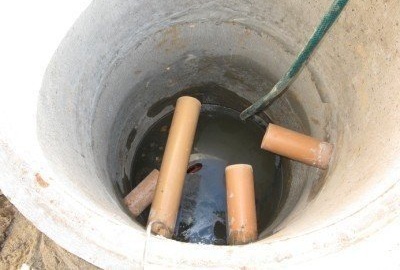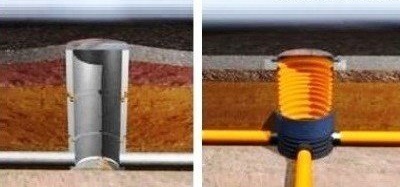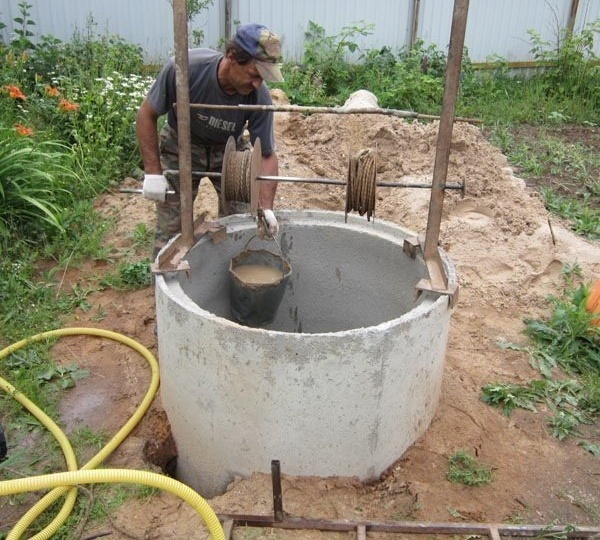Features of connecting the drainage well to the drainage system

When building a new house or reconstructing an old one, modern homeowners cannot ignore the issue of building a local area. And most often they are interested in how you can build a drainage well with your own hands, without the involvement of specialists. Indeed, at first glance, special difficulties with this cannot arise. But before considering the construction of a drainage well, it is necessary to understand what it can be in principle.
What types of drainage wells exist?
Option # 1 - Swivel Design
Through it, periodic cleaning of sediments occurs, which inevitably accumulate under the pressure of water in the cavities of perforated pipes. Thus, no matter what version the drainage system has, it will not be possible to do without a rotary well.
It settles down at every second turn of the drainage pipeline and in places of convergence of several drains. The size of a drainage well of this type depends on one single factor - human. If it is assumed that during repair a person will sink into it, then its diameter will be 1 m, but in this case it will go into the category of inspection wells.
Option # 2 - viewing well
It is an indispensable structural element of any drainage system. It is an engineering structure for its control and inspection. Its dimensions should be sufficient so that a person can descend inside. The viewing drainage well can act as a swivel if it is located at the point of convergence of several drainage pipes or at a bend in the pipeline.
Option # 3 - Absorption Well
It is often used in everyday life as filtering, characterized by a special location on the site. An absorption drainage well is a point structure located in a place where there is a need for draining the territory. The depth of the drainage well for this purpose cannot be less than 2 m.
Option # 4 - Manifold Well
Also known as a drainage well. In fact, this is the final reservoir of the closed drainage system. Its functional purpose is to collect and accumulate water, which is periodically pumped to a safe place: ravine, ditch, pond.
To install such a structure, plastic wells for drainage are used, in a sufficient assortment, available on the market. They are leakproof and have a waterproof bottom.
What material to make such a well from?
In principle, finding the answer to this question will not be difficult, because in practice drainage pipes and wells are:
- Concrete. The device uses concrete rings of different diameters and heights. They are installed in pre-dug trenches using a crane. The advantages are durability and strength.The disadvantage is the complexity of installation.
- Plastic. Today they are clear “favorites” in the construction of drainage systems. Special drainage pipes and wells are offered ready-made and have indisputable advantages: low weight; simplicity and speed of installation; the availability of all necessary bends; inertness to biological corrosion; service life not less than 50 years.
During installation, plastic wells for drainage are connected to the pipes using cuff rubber seals, which allows to maintain tightness for more than a dozen years. Also, with the installation of such a drainage well, one can not do without a corrugated pipe, which is held in the ground thanks to stiffeners.
Algorithm for installation work
And simple rotary structures, and manholes for drainage, and other structures of this kind made of plastic, in principle, are arranged according to the same working scheme:
- Corrugated pipe is cut to the correct size. Then, holes are made in it to which perforated pipes will be supplied, using sealing cuffs.
- A ditch is dug, at the bottom of which a crushed-sand pillow is being built. Then it is poured with cement mortar, and on top it is covered with geotextiles.
- The bottom is installed on the prepared place. Then it connects it to the corrugation, not forgetting to pre-smear the junction with bitumen mastic.
- Next, the elements of the drainage pipeline are brought in, the joints are also sealed with mastic.
- A pump is designed for pumping out accumulated water (if a water intake drainage well is arranged).
- The void around the well shaft is covered with crushed stone of a small fraction.
- The cover is installed.
- Next, you have to tamp the upper surface around the drainage well and make a cement frame into which the manhole cover is installed.
In order to avoid clogging of the drainage system and laborious repair work, it is necessary to periodically clean the drainage wells. These engineering structures do not need other care if the technology is fully observed during the installation process.
We hope you are convinced that creating a drainage system is not at all difficult, although this article is devoted only to one of the stages of its construction. Now you know exactly how to make a drainage well with your own hands, and as an addition we suggest that you familiarize yourself with a training video with tips on how to arrange a drainage.





